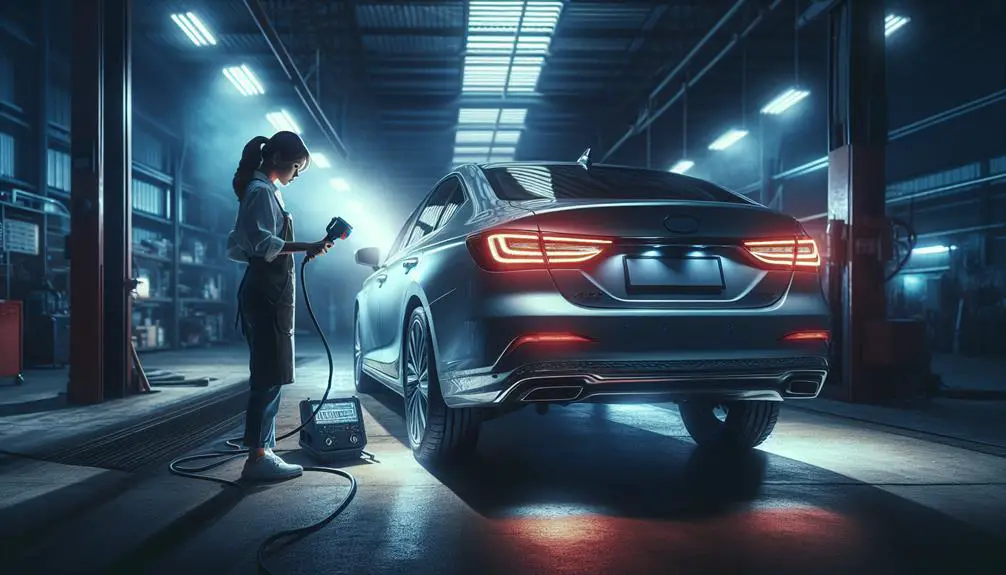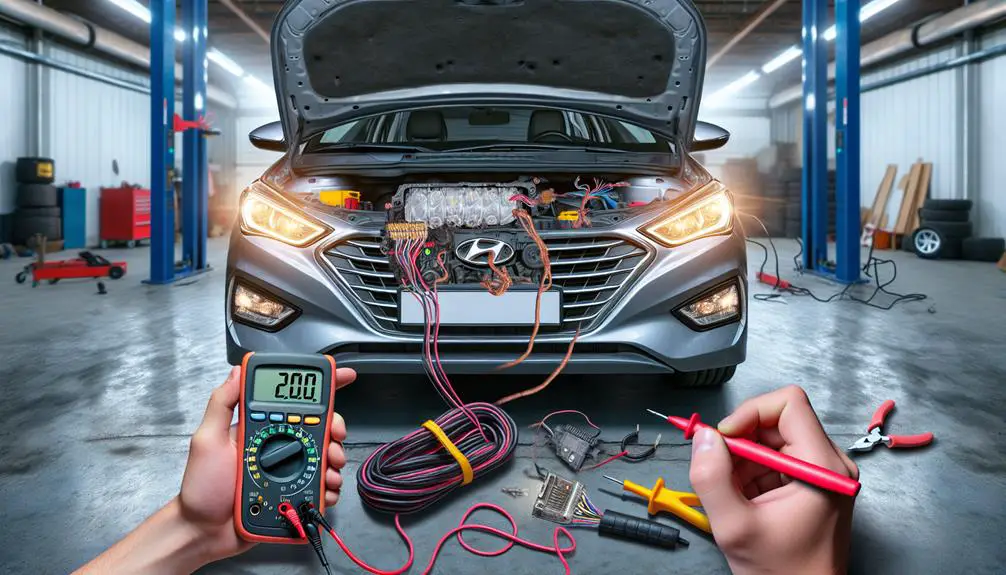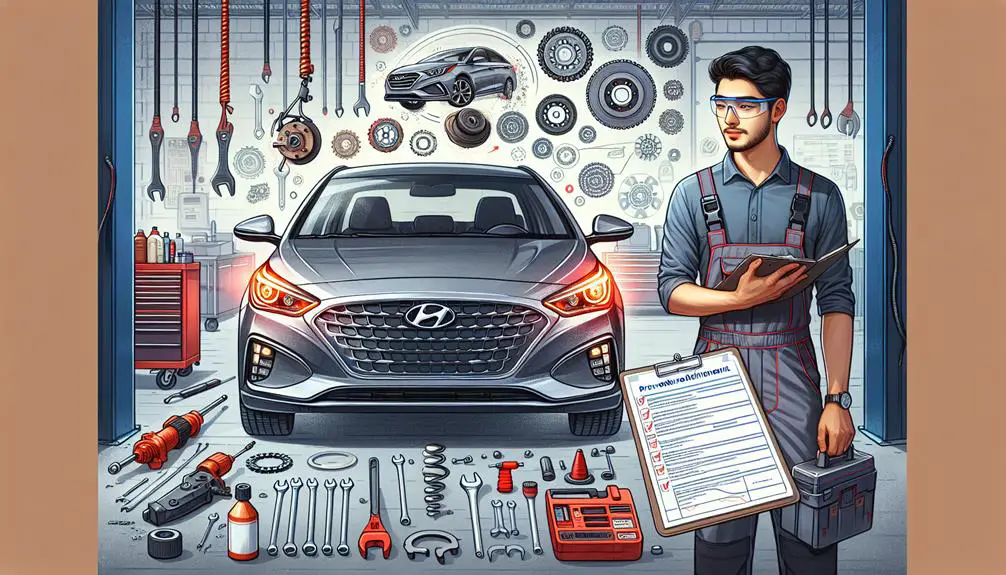Inspect the brake light switch.
Check the electrical connections.
Identifying the Problem

To identify the problem with your Hyundai Sonata's brake lights staying on, make sure the brake pedal isn't stuck or depressed. Sometimes, it's the most important things that you overlook. If the pedal's fine, then you're dealing with something a bit more complex.
Next, you'll want to check the brake light bulbs themselves. It's rare, but possible, for faulty wiring or bulbs to cause the lights to remain on. If you've got a multimeter, you can test the connection to see if there's a constant supply of power, which there shouldn't be when you're not pressing the pedal.
After you've ruled out the pedal and the bulbs, consider the possibility of a drained battery or a faulty alternator. While these issues don't directly cause brake lights to stay on, they can lead to electrical quirks. Your car's electrical system relies on a healthy battery and alternator, so if either is failing, you might notice odd behavior like this.
Don't forget to take a look at the fuse box, too. A blown fuse mightn't be the initial cause of your brake lights issue, but it can indicate where the electrical system is failing. Replacing a blown fuse mightn't fix the problem, but it's an important step in troubleshooting.
Inspecting the Brake Light Switch
After checking the simpler issues, it's important to inspect the brake light switch, as it's often the culprit behind your Hyundai Sonata's brake lights staying on.
The brake light switch is a small but vital component located near the top of the brake pedal. It's responsible for turning your car's brake lights on and off. When you press the brake pedal, the switch activates, illuminating the brake lights. When you release the pedal, the switch should deactivate, turning the lights off. If the switch is faulty or misaligned, it can cause the lights to remain on.
Initially, you'll need to locate the switch. Get down by the driver's side footwell and look up towards the top of the brake pedal. You should see a switch with a plunger that contacts the pedal arm.
Check if the switch is properly aligned. Misalignment can prevent the switch from fully disengaging when you release the brake pedal. If it's out of place, gently adjust it until it's correctly aligned with the pedal arm.
Next, inspect the switch for any signs of damage or wear. Look for cracks, corrosion, or other visible damage. If the switch looks physically damaged, it's likely the cause of your problem and needs to be replaced.
Testing the switch for functionality might require a multimeter. However, if you're not comfortable using one, consider replacing the switch if it shows physical signs of failure. Switches are relatively inexpensive, and replacing one could quickly solve your brake light issue.
Checking Electrical Connections

Inspecting the brake light switch might reveal it's not the source of the problem, leading us to examine the electrical connections next. This step is important because even a slight misalignment or wear in the wiring can cause your Hyundai Sonata's brake lights to stay on.
Here's what you need to focus on:
- Inspect the Wiring Harness: Check for any visible signs of wear, tear, or corrosion on the wiring harness that connects to the brake light switch. Any damage here can disrupt the normal operation of your brake lights.
- Ensure Tight Connections: Loose connections can often be the culprit. Make sure all electrical connections in the brake light circuit are secure and tight.
- Look for Shorts in the System: A short circuit in the brake light system can cause the lights to remain on. Use a multimeter to check for shorts, paying close attention to the area around the brake light switch and tail lights.
- Ground Connection Check: A faulty ground connection can lead to different electrical issues, including the brake lights staying on. Make sure the ground connection is clean, secure, and free from corrosion.
- Fuse Inspection: While it's not directly a wiring issue, a blown fuse can sometimes indicate problems in the electrical circuit that might affect the brake lights. Check the fuse box for any blown fuses related to the brake light system.
Replacing Faulty Parts
Once you've identified the malfunctioning components in your Hyundai Sonata's brake light system, it's crucial to replace these faulty parts promptly. Delaying can lead to safety issues and potentially more complex repairs down the line.
Initial off, if you've pinpointed the brake light switch as the culprit, you're in luck since it's generally an easy and affordable fix. You'll need to purchase the correct replacement part for your Sonata model year. Once you have the new switch, locate the old one near the brake pedal, disconnect it, and replace it with the new one. It's a straightforward process that doesn't require special tools, but make sure the new switch is properly aligned to ensure it functions correctly.
In cases where the issue lies within the wiring or the brake light bulbs themselves, you'll need a bit more patience. For bulbs, simply remove the cover of the brake light, unscrew the faulty bulb, and screw in a new one. Ensure you're using the correct bulb type to avoid any mismatch issues.
If the problem is with the wiring, it's a bit trickier. You might find it helpful to consult a repair manual or a professional for guidance. Exposed or frayed wires should be replaced or repaired immediately to prevent short circuits.
Preventative Maintenance Tips

To keep your Hyundai Sonata's brake lights working flawlessly, regularly checking and maintaining the entire brake system is key. Preventative maintenance isn't just about avoiding those moments when your brake lights won't turn off; it's additionally about ensuring your safety on the road. Here's what you need to do:
- Check the Brake Light Switch Regularly: This switch is a common culprit for brake light issues. If it's faulty or improperly adjusted, it could cause your brake lights to stay on. Inspect it periodically and adjust or replace it if necessary.
- Inspect Brake Light Bulbs and Sockets: Sometimes, the problem isn't complex at all. Faulty bulbs or corroded sockets can cause issues. Check these components and replace them if you find any damage or wear.
- Examine the Brake System Wiring: Wiring issues can lead to numerous electrical problems, including your brake lights malfunctioning. Look for any signs of wear, tear, or rodent damage and address them promptly.
- Keep an Eye on the Fuse Box: A blown fuse can sometimes lead to brake lights staying on. Make sure you check your Sonata's fuse box for any blown fuses and replace them as needed.
- Schedule Regular Professional Inspections: Sometimes, the best thing you can do is let the pros handle it. Regular check-ups by a professional can catch issues you might miss and prevent future problems.
Conclusion
You've now tackled the issue of your Hyundai Sonata's brake lights refusing to shut off. By identifying the problem, inspecting the brake light switch, checking electrical connections, and replacing any faulty parts, you're back in control.
Remember, keeping up with preventative maintenance can save you from future headaches. So, take this experience as a cue to stay ahead with regular checks.
Your Sonata's now in top shape, ready for the road ahead. Keep it that way!